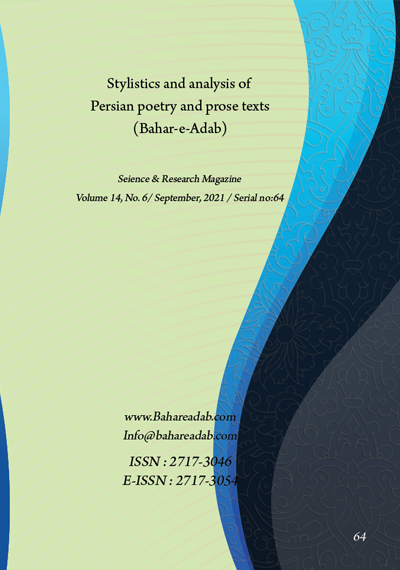- Count View : 466
- آدرس کوتاه شده مقاله: https://bahareadab.com/article_id/1142
- کد doi مقاله: Doi: 10.22034/bahareadab.2021 .14 .5398
Journal of the stylistic of Persian poem and prose
volume Number 14،
number In Volume 6،
،
issue Number 64
Analysis of stylistic components in the poems of Mirzadeh Eshghi and Mohammad Taghi Bahar
Marivan Hossein Farhan (Author in Charge), Seyyed Ahmad Parsa
Abstract
BACKGROUND AND OBJECTIVES: Sustainability literature is a reflection of the reactions of oppressed nations and their dissatisfaction with the current situation; Therefore, the literature of stability, in spite of linguistic, temporal, cultural, religious, geographical and similar differences, pursues a single mission, and that has been the awakening of the masses of the people and their incitement against the occupiers of their land or its oppressive rulers. The subject of the present study is the analysis of stylistic components in the poems of Mirzadeh Eshghi and Mohammad Taghi Bahar.
METHODOLOGY: The research method is descriptive-analytical; The data were collected in the form of libraries and analyzed by content analysis.
FINDINGS: The poetic motifs of the constitutional era are almost common in the poetry of the poets of that era, but the approach of each of them is different from the other and indicates his own worldview. This is also true of the sustainability motif.
CONCLUSION: Mirzadeh Eshghi"s extensive use of the manifestations of folklore in expressing the concepts and issues of sustainability has caused folklore to play a prominent role as a stylistic feature in such poems. The reflection of folk beliefs and the use of idioms, allusions, similes and proverbs are the most important manifestations of folklore in the poems of Mirzadeh Eshghi. In contrast, Bahar has not used much of the effects of folklore in his poems on sustainability and has expressed the concepts of sustainability more in harsh and literary language. Intellectually, love is more radical than spring. In the beginning, Bahar"s discourse, regardless of his linguistic maturity, is like a love with a cracking language, and it represents an unyielding discourse and all the protests in Ahmad Shah"s period until the beginning of Reza Shah"s period. But very soon after his imprisonment, this discourse changed and criticism gave way to praise of Reza Shah. In other words, stability in spring poetry gives way to submission and silence.
Keyword
Sustainability Literature
, Stylistics
, Folklore
, Mirzadeh Eshghi
, Mohammad Taghi Bahar
- Parvini, Khalil. (2015). Pathology of Comparative Literature in the Arab World, Critical Research Journal of Humanities Texts and Programs, Institute of Humanities and Cultural Studies, No. 34, pp. 20-36.
- Al-Khatib, Hussam. (1992). Horizons of Arabic Literature and World Studies, Beirut: Dar al-Fikr al-Moaser, p. 50.
- Sangari, Mohammad Reza. (2004). Sustainability Literature, Poetry Magazine, No. 39, Winter, pp. 45-53.
- Shafi'i Kadkani, Mohammad Reza. (2008). Persian Poetry Periods, Tehran: Sokhan, pp. 35-39.
- Isaiah, Reza. (2006). Imam and Sustainability Literature, Matin (30) 8, pp. 121-143.
- Dehkhoda, Ali Akbar. (1982). Proverbs and rulings, Volume 2, Tehran: Amirkabir, p.702.
- Bahar, Mohammad Taghi. (2008). Divan, Tehran: Negah.
- Mirzadeh Eshghi, Mohammad Reza. (1971). Divan, Edited by Ali Akbar Moshir Salimi, Tehran: Amirkabir.
- Shamisa, Sirus. (2012). Stylistics of Poetry, Tehran: Mitra, p. 328.

